Sociopath vs. Autism

Understanding the Core Differences and Overlaps
Sociopathy and autism spectrum disorder (ASD) are often misunderstood, leading to misconceptions that hinder accurate diagnosis and appropriate support. While both conditions impact social functioning, they stem from distinct causes and exhibit unique behavioral patterns. This article explores the nuanced differences and unexpected similarities between sociopathy and autism, offering insights from psychological and medical perspectives to deepen understanding and promote informed societal attitudes.
Foundational Definitions and Core Characteristics
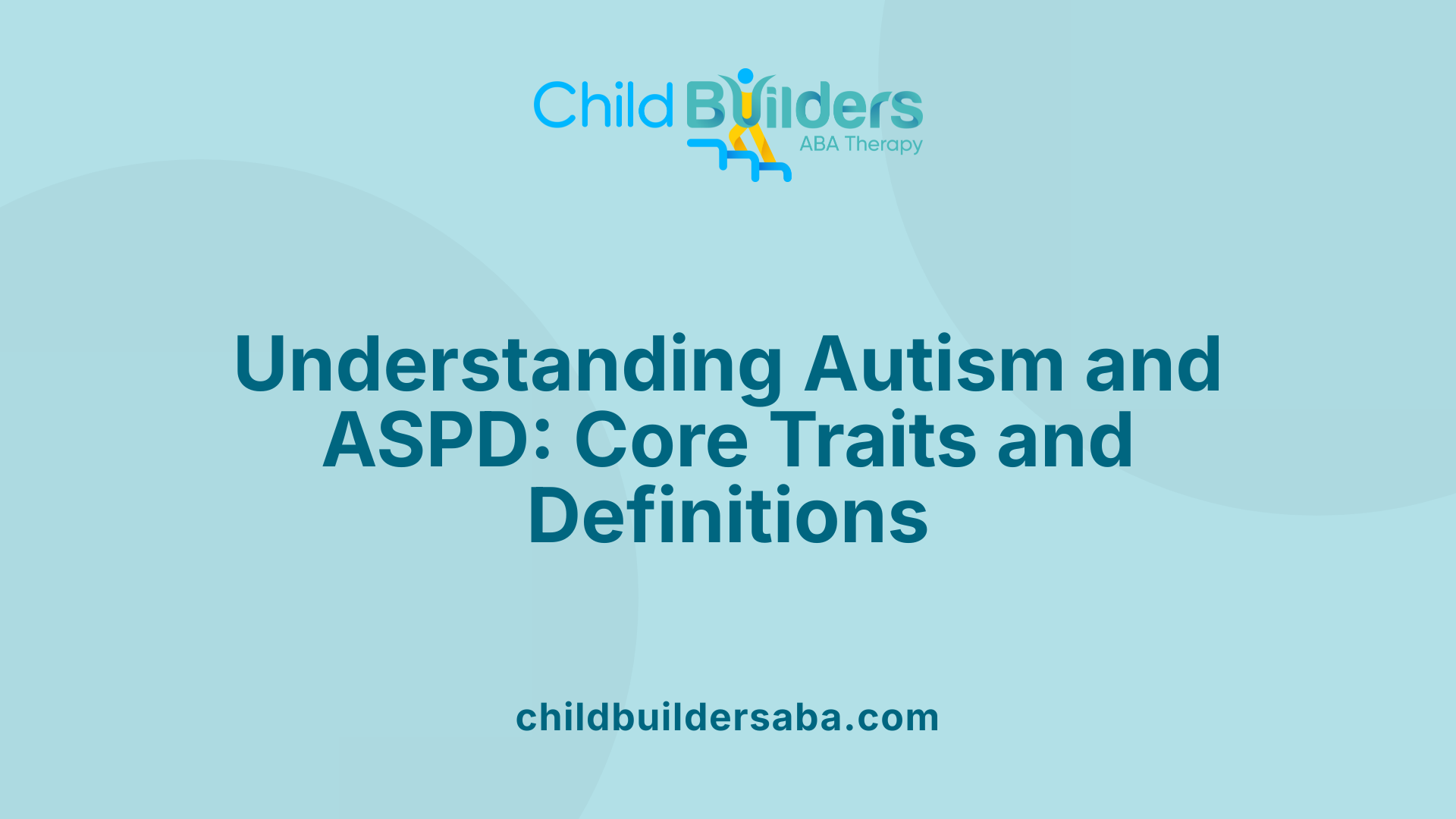
What are sociopathy and ASPD?
Sociopathy, officially known as Antisocial Personality Disorder (ASPD), describes a pattern of behaviors marked by disregard for social norms, manipulation, impulsivity, and a lack of remorse. Individuals with ASPD often engage in law-breaking activities, deceitfulness, and show little concern for the rights or feelings of others. They may appear charming and charismatic on the surface but tend to exploit others for personal gain, displaying superficial charm mixed with impulsive or reckless actions.
What is autism spectrum disorder?
Autism Spectrum Disorder (ASD) is a neurodevelopmental condition characterized by persistent challenges in social interaction, communication, and the presence of restricted or repetitive behaviors. People with autism often experience sensory sensitivities, pragmatic language difficulties, and a strong preference for routines and focus on specific interests. Unlike sociopathy, autism is diagnosed in early childhood and reflects differences in brain development affecting social cognition and sensory processing.
Key behaviors associated with each
| Behavior Type | Sociopathy (ASPD) | Autism Spectrum Disorder | Core Difference / Similarity |
|---|---|---|---|
| Social Skills | Superficial charm, manipulative, exploitative | Difficulties in understanding social cues, pragmatic language challenges | Sociopaths can be socially skilled, autistic individuals often socially awkward |
| Empathy | Lack of affective empathy, emotional coldness | Often have intact affective empathy but difficulty with cognitive empathy | Different emotional profiles but some overlap in social misinterpretation |
| Emotional Response | Shallow emotions, emotional detachment | Intense emotions but challenges in regulation | Both may exhibit social withdrawal or atypical emotional behavior |
| Behavioral Patterns | Impulsive, risk-taking, sometimes criminal | Repetitive behaviors, insistence on routines | Disruptive behaviors are distinct: impulsivity vs. rigidity |
| Diagnosis | Behavioral patterns in adulthood, law-breaking, deceit | Early childhood signs, persistent social and communication challenges | Diagnostic criteria focus on different developmental stages |
What are the key differences and similarities between sociopathy and autism spectrum disorder?
Sociopathy, or ASPD, involves a pattern of manipulative, impulsive, and sometimes criminal behaviors driven by an emotional deficit and disregard for others' rights. These individuals often lack genuine remorse, and their social manipulations are motivated by self-interest. Conversely, autism spectrum disorder is a neurodevelopmental condition where challenges stem from differences in brain development affecting social cognition, communication, and sensory processing.
While both groups might display difficulties in understanding and responding to social cues, the root causes differ significantly. Autistic individuals tend to care about others’ feelings and may want social connections, but struggle to interpret cues accurately due to pragmatic language and sensory issues. Sociopaths usually exhibit diminished emotional responsiveness altogether, often masking their lack of empathy behind superficial charm.
In terms of behavior, sociopaths tend toward impulsivity and risk-taking, sometimes engaging in criminal acts and showing erratic behavior. Autistic individuals, on the other hand, may have a strong need for routines, engage in repetitive behaviors, and respond intensely to sensory stimuli. These differences influence their management and intervention strategies, with autism benefiting from early behavioral therapies and sociopathy typically requiring behavioral management and emotional regulation interventions.
Despite these distinctions, some research indicates potential overlaps. For example, some autistic individuals may display callous-unemotional traits similar to those found in antisocial behaviors. Recognizing these nuances is critical for accurate diagnosis and appropriate support.
How do diagnosis and treatment differ?
Autism is diagnosed through behavioral assessments in early childhood, focusing on persistent social communication difficulties and restricted interests, with interventions such as Applied Behavior Analysis (ABA), speech therapy, and social skills training. Treatment aims to promote social functioning, communication, and sensory integration.
In contrast, ASPD or sociopathy is identified mainly in adulthood based on longstanding behavioral patterns, including law-breaking, deceit, impulsivity, and a lack of remorse. Treatment approaches focus on managing behaviors through psychotherapy, behavioral therapy, and sometimes medication to address impulsivity and emotional dysregulation.
Understanding these differences ensures tailored support and reduces the risk of misdiagnosis. While autism and sociopathy are distinct conditions, nuanced assessments are necessary to account for overlapping traits, especially in complex cases or forensic settings.
Behavioral and Emotional Profiles: A Diagnostic Perspective
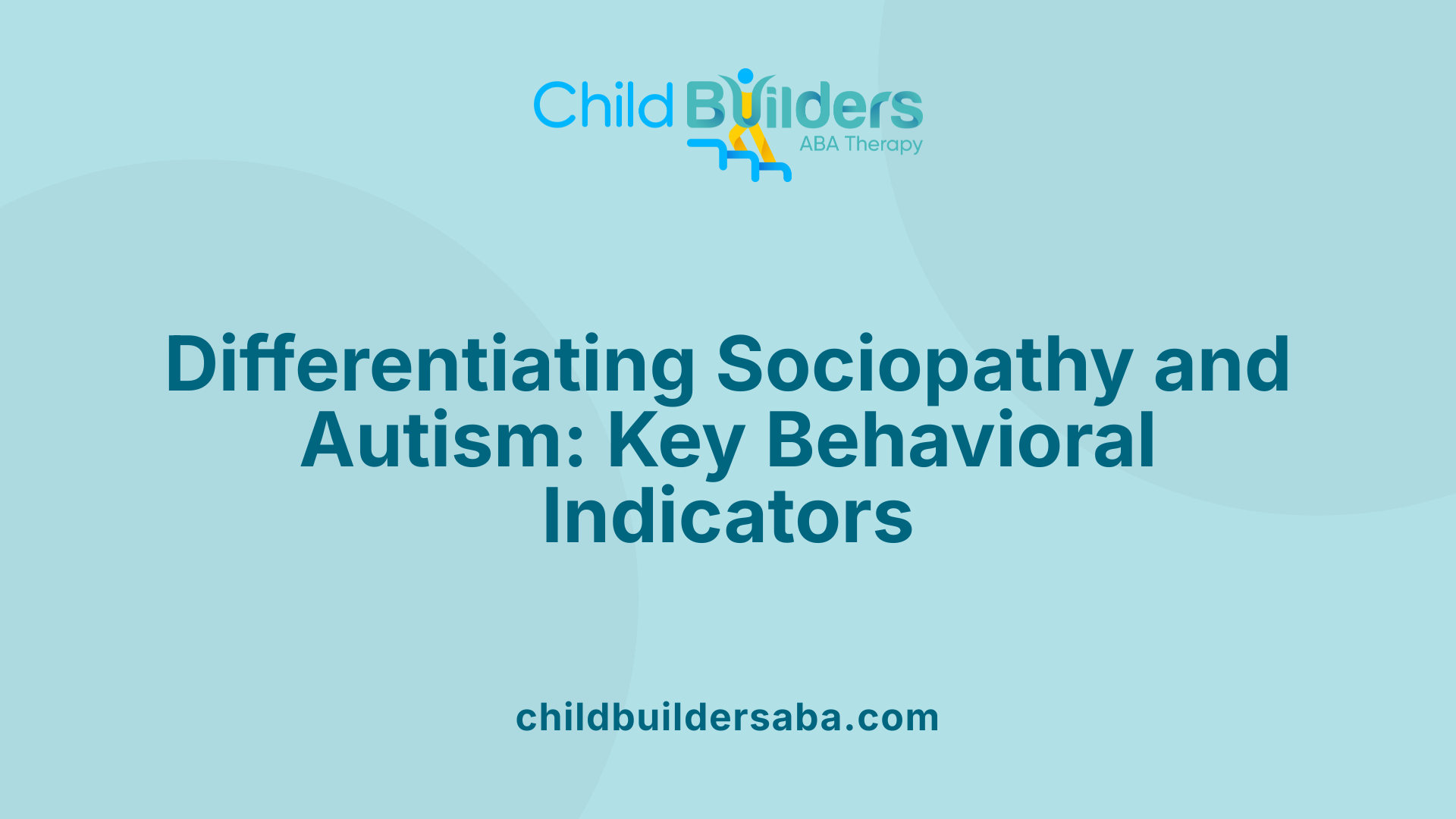
How can one differentiate between traits of sociopaths and autistic individuals for diagnostic purposes?
Distinguishing sociopaths from individuals on the autism spectrum involves examining core behavioral and developmental differences. Sociopaths, or those with antisocial personality disorder (ASPD), typically show a pattern of impulsivity, manipulative behavior, a marked lack of remorse, and may engage in criminal acts or risky behaviors. These traits usually develop in adolescence or adulthood, often associated with genetic factors and environmental influences.
In contrast, autism spectrum disorder (ASD) presents early in life, with persistent challenges in social communication, restrictive interests, and repetitive behaviors. Autistic individuals often desire social connection but struggle to interpret social cues and show difficulties with social reciprocity. Their behaviors stem from neurodevelopmental differences rather than personality disorders.
The emotional responses also differ markedly: sociopaths tend to have shallow or detached emotions, often capable of cognitive empathy—understanding others’ mental states—yet lacking affective empathy—real emotional concern. Conversely, autistic individuals usually retain affective empathy but may have difficulty with cognitive empathy, making it harder for them to understand and respond appropriately to others’ feelings.
Another significant distinction involves the onset and motivation behind behaviors. Sociopathic traits generally manifest in behaviors aimed at personal gain or defiance, with impulsive actions often driven by immediate gratification. Autism behaviors originate from neurodevelopmental pathways, with behaviors such as insistence on routines or sensory sensitivities rooted in early childhood.
Assessment tools, detailed developmental histories, and behavioral observations are crucial in the diagnostic process. For example, early signs of autism—such as delayed speech, lack of babbling, and early social engagement difficulties—contrast with the later emergence of antisocial behaviors typical of sociopaths.
In summary, clinicians look at the age of onset, motivation behind behaviors, emotional and social processing, and developmental history to differentiate between sociopaths and autistic individuals effectively. Accurate diagnosis ensures that support systems and interventions are appropriately tailored to each condition’s unique needs.
Dispelling Myths and Clarifying Misconceptions
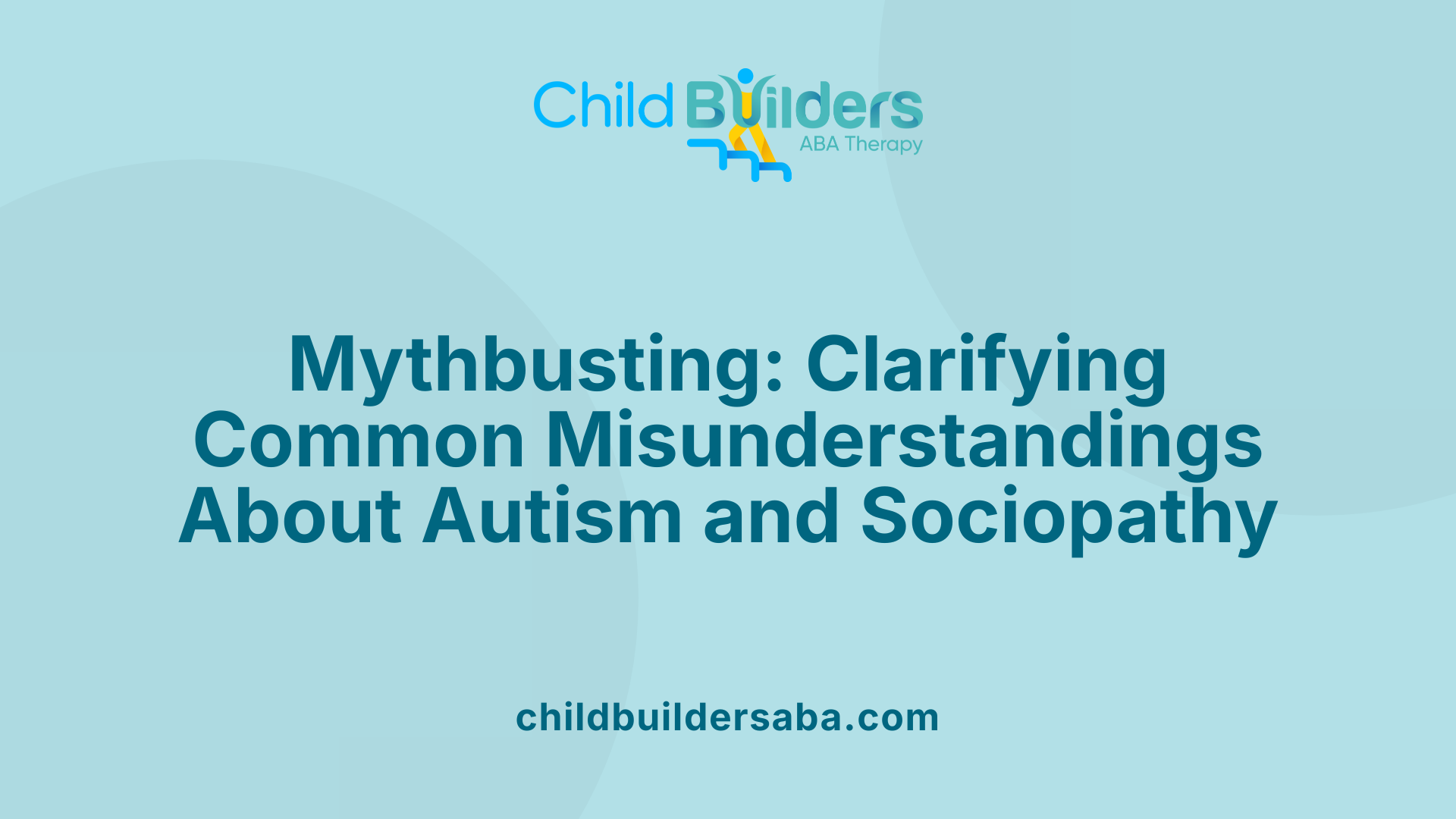
What misconceptions exist about sociopathy and autism, and how can they be clarified?
Many misunderstandings surround autism and sociopathy, often blending traits or attributes that are actually quite different. A prevalent myth is that all autistic people lack empathy or that they are inherently cold and emotionless. This is inaccurate; individuals on the autism spectrum often experience intense emotions and may desire social connection, but they struggle with understanding social cues and expressing emotions in typical ways. Their social differences are rooted in neurodevelopmental factors affecting communication and sensory processing.
In contrast, sociopathy, or antisocial personality disorder (ASPD), is characterized by manipulative, impulsive, and often risky behaviors. People with sociopathy typically show a significant lack of affective empathy, meaning they do not genuinely feel others' emotions, and often do not regret their harmful actions. They might understand others’ mental states cognitively—a trait known as cognitive empathy—but this understanding does not evoke emotional concern.
The timing of diagnosis further highlights the differences. Autism traits are usually evident from early childhood, as they involve developmental differences. Sociopathy, on the other hand, is primarily diagnosed in adulthood, preceded by conduct disorder during childhood. These distinct developmental timelines emphasize that autism is neurobiological and developmental, while sociopathy relates more to personality, behavior, and possibly genetic and environmental influences.
Understanding these differences is crucial for reducing stigma and fostering support. Instead of viewing autistic individuals as lacking empathy, it is more accurate to recognize that they may experience and express emotions differently. Clarifying these misconceptions helps families, educators, and clinicians provide appropriate interventions and promotes societal acceptance.
How do empathy and emotional expression differ between autism and sociopathy?
Autistic individuals often have intact affective empathy—the capacity to feel others' emotions—yet they may face challenges with cognitive empathy, the ability to understand others' thoughts and feelings. This can lead to misunderstandings in social interactions, but it does not mean they are unemotional or uncaring.
Conversely, sociopaths typically lack affective empathy, making it difficult for them to genuinely feel remorse or compassion. They may perform manipulative behaviors with awareness of how others feel, but their actions are largely driven by self-interest rather than emotional connection.
Emotionally, autistic people might experience intense emotions yet struggle with regulation and expression, often appearing aloof or unresponsive. Sociopaths often show shallow emotions and exhibit emotional detachment, displaying superficial charm but little genuine feeling.
This distinction in emotional processing influences how each group's social behaviors manifest, highlighting the importance of accurate understanding and tailored approaches for support.
When are diagnoses made, and what are the underlying causes?
Autism spectrum disorder is identified early in life, often by the age of three or even sooner, based on persistent difficulties in social communication, repetitive behaviors, and sensory sensitivities. Its roots lie in neurodevelopmental differences, primarily involving genetics, brain structure, and developmental processes that affect social and communication skills.
Contrastingly, antisocial behaviors characteristic of sociopathy become apparent only in adolescence or early adulthood. The diagnosis of ASPD requires a pattern of disregard for others' rights that begins before age 15 with conduct disorder and continues into adulthood.
The causes of sociopathy involve a complex interplay of genetic predispositions, environmental influences, and neurobiological factors. Differences in brain regions such as the prefrontal cortex and amygdala have been linked to the impulsivity, risk-taking, and emotional underdevelopment seen in sociopaths.
In summary, autism is a developmental neurobiological condition noticeable early in life, while sociopathy emerges later and is associated more with personality development, environment, and possibly genetic vulnerabilities. Recognizing these distinctions helps in applying appropriate support and interventions, ultimately fostering better understanding and societal integration for individuals with these conditions.
Overlapping Traits and Distinct Underlying Factors
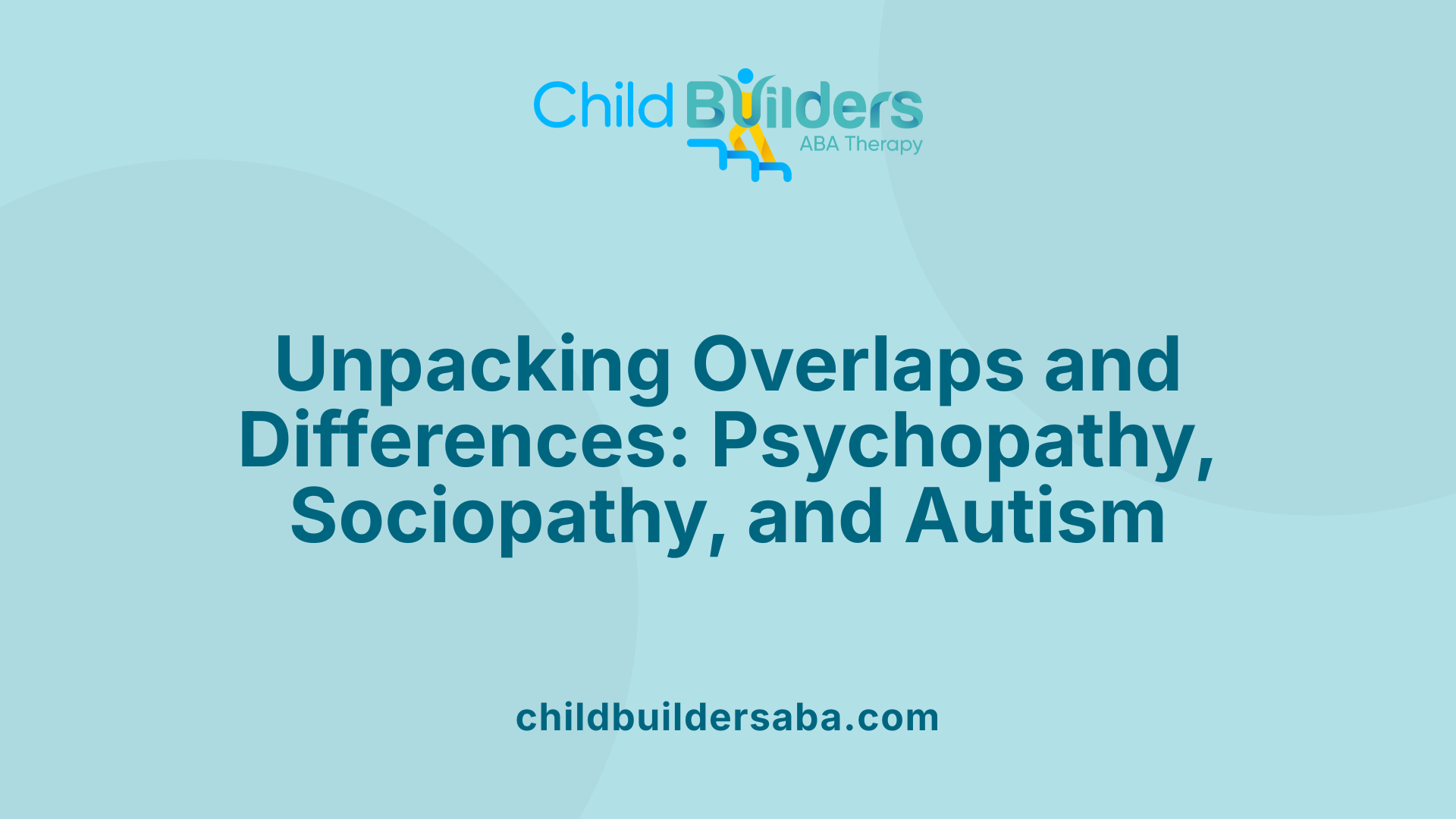
What are the overlaps and differences between psychopathy, sociopathy, and autism?
Psychopathy and sociopathy are terms that fall under the broader diagnosis of antisocial personality disorder (ASPD). While they share certain traits, distinctions exist in their underlying causes and behavioral expressions.
Psychopaths tend to exhibit emotional detachment, superficial charm, manipulative behaviors, and a lack of remorse. These traits are believed to have neurobiological roots, including differences in brain regions like the amygdala and prefrontal cortex, which affect emotional processing and impulse control.
In contrast, sociopaths often display impulsivity, irritability, and a tendency toward risk-taking or aggression. These behaviors are typically influenced more by environmental factors, such as traumatic childhood experiences or unstable social environments.
Autism spectrum disorder (ASD), on the other hand, is primarily a neurodevelopmental condition characterized by difficulties in social interaction, communication, and behavioral rigidity. Despite challenges in understanding social norms, individuals with ASD usually desire social connection and often possess strong affective empathy. Their social difficulties stem from impaired cognitive understanding of social cues rather than a lack of emotional capacity.
Although there can be apparent behavioral overlaps—such as aggression, difficulty recognizing social cues, or social withdrawal—the core motivations differ significantly. Psychopaths often manipulate others and act without remorse, whereas individuals with ASD may struggle with social understanding despite genuine emotional concern.
The causes of these conditions are also different. Psychopathy is linked to genetic and neurobiological factors, while sociopathy tends to develop from environmental influences. Autism results from atypical brain development involving genetic and prenatal factors.
Below is a comparative table summarizing the main features:
| Trait/Aspect | Psychopathy | Sociopathy | Autism Spectrum Disorder |
|---|---|---|---|
| Underlying Cause | Neurobiological | Environmental/Trauma | Neurodevelopmental |
| Emotional Capacity | Lack of affect, remorse | Variable, often shallow emotions | Affected, but often genuine and strong |
| Empathy | Impaired affective and cognitive empathy | Reduced affective empathy, variable cognitive empathy | Usually high affective empathy; difficulty in cognitive empathy |
| Social Behavior | Manipulative, charming, calculated | Impulsive, erratic, sometimes charming | Difficult understanding social norms, but desire social connection |
| Typical Onset | Usually by early adulthood | Childhood/Adolescence | Early childhood |
| Main Challenges | Emotional detachment, manipulation | Impulsivity, aggression, irresponsibility | Communication, social cues, repetitive behaviors |
Understanding the distinctions between these conditions helps in accurate diagnosis and tailored interventions. Although behaviors may sometimes superficially resemble one another, their roots and implications are fundamentally different, necessitating specific therapeutic approaches and social understanding.
Diagnostic Hallmarks and Behavioral Indicators
What are the diagnostic criteria and hallmark traits that differentiate sociopathy from autism?
Sociopathy, also known as antisocial personality disorder (ASPD), is primarily identified through behavioral patterns that include impulsivity, deceitfulness, manipulative behaviors, and a blatant disregard for social norms and others’ rights. Diagnosing ASPD involves a documented history of conduct disorder during childhood, with characteristics such as law-breaking, irresponsibility, irritability, and a lack of remorse for harmful actions. Individuals often appear charming and charismatic but exploit others for personal gain, showing little concern for safety or the feelings of others.
Autism spectrum disorder (ASD), on the other hand, is a neurodevelopmental condition characterized by persistent difficulties in social interaction, impaired communication, and restricted or repetitive behaviors. These symptoms typically present early in childhood, often before age three, and are observable through challenges with social reciprocity, pragmatic language use, and understanding social cues.
The distinct hallmark traits help differentiate the two. Sociopaths generally show affective empathy deficits—they can often understand others' thoughts but lack emotional concern or remorse—and may manipulate or harm others intentionally. They often act impulsively and may engage in criminal or risky activities without remorse. Autism, however, involves difficulties primarily with social cognition and understanding social norms, but individuals may possess affective empathy and genuine concern for others’ feelings.
The differential onset and neurobiological roots are also key: autism is rooted in brain differences affecting social development, with genetic and early developmental factors influencing its manifestation. Sociopathy, conversely, is considered to develop from a combination of genetic predisposition and environmental influences, affecting personality formation.
In summary, while both conditions can involve social impairments, their causes, developmental timelines, and behaviors are markedly different. Autism’s core lies in neurodevelopmental differences affecting communication and social understanding, whereas sociopathy centers around personality disorders characterized by manipulative behaviors, impulsivity, and a lack of remorse.
Clinical Perspectives and Diagnostic Approaches
How can medical and psychological perspectives aid in distinguishing sociopathic behaviors from autism traits?
Medical and psychological assessments play a crucial role in differentiating between traits of sociopathy and autism. Both conditions can exhibit overlapping behaviors such as social difficulties and impulsivity, but their underlying causes and expressions differ significantly.
Clinicians begin by gathering a comprehensive developmental and behavioral history. Autism spectrum disorder (ASD) typically features persistent challenges in social communication, repetitive behaviors, and sensory sensitivities that are present from early childhood. In contrast, sociopathy, or antisocial personality disorder (ASPD), generally manifests through patterns of deceit, manipulation, impulsivity, and disregard for social norms, usually emerging in adolescence or adulthood.
To support diagnosis, specialized tools are used. For autism, instruments like the Autism Diagnostic Observation Schedule (ADOS) and Autism Diagnostic Interview-Revised (ADI-R) evaluate social interactions, communication skills, and repetitive behaviors. These focus on core autism symptoms and their severity.
Assessments for sociopathy involve behavioral evaluations that emphasize a person’s impulse control, history of law-breaking, and attitude toward others’ rights. Psychologists look for traits such as superficial charm, lack of remorse, and manipulativeness, often confirmed through structured clinical interviews and personality assessments.
An essential element is analyzing emotional responses and empathy. While autistic individuals may demonstrate genuine emotional concern but struggle with social reciprocity, sociopaths generally exhibit emotional detachment, superficial affect, and a capacity for premeditated manipulation.
Further differentiation involves examining the influence of neuropsychological factors. People with autism often show strengths in detailed-focused tasks but difficulties with pragmatic language, whereas sociopaths may demonstrate intact or even superior ability to read social cues but lack emotional engagement.
Overall, these evaluations ensure accurate diagnosis, which is vital for effective intervention. Autism benefits from behavioral therapies and social skills training, while sociopathy may require behavior management, therapy focusing on impulse control, and addressing underlying environmental influences.
By analyzing behavioral patterns, developmental history, and neuropsychological data, clinicians can distinguish between these conditions, guiding suitable treatment approaches and fostering better societal understanding.
Implications for Society and Support Strategies
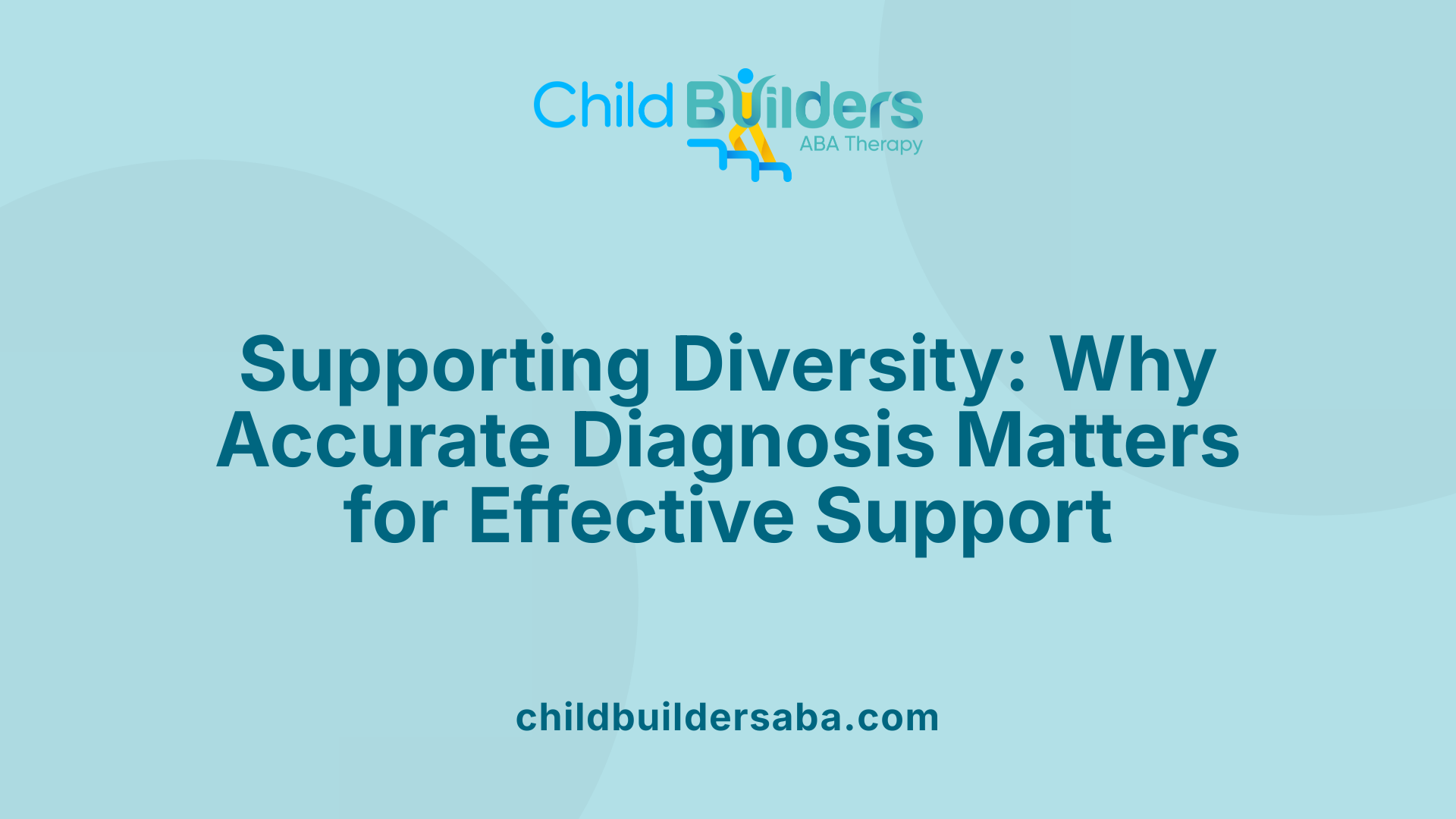
Why is it important to have an accurate diagnosis of conditions like autism and sociopathy?
Understanding the fundamental differences between autism spectrum disorder (ASD) and sociopathy (antisocial personality disorder, ASPD) is crucial for providing appropriate support and management. Autism is a neurodevelopmental condition present from early childhood, characterized by social communication difficulties, repetitive behaviors, and sensory sensitivities. These individuals often want social connection but struggle due to cognitive and sensory differences.
In contrast, sociopathy is rooted in environmental factors and genetic predispositions, manifesting as manipulative behaviors, impulsivity, lack of remorse, and difficulty adhering to social norms. These traits typically emerge in adolescence or early adulthood, often involving criminal or antisocial acts.
Accurate diagnosis ensures that each person receives support tailored to their specific needs. Mislabeling an autistic person as sociopathic can lead to punitive measures rather than helpful interventions, while misunderstanding sociopathy as autism can overlook risks and dangerous behaviors that require management.
How do tailored intervention approaches differ for autism and sociopathy?
Interventions for autism focus on early behavioral therapies, social skills training, speech therapy, and sensory integration techniques. The goal is to improve communication, reduce sensory overload, and foster greater independence.
Sociopathy requires different strategies; management often involves behavioral therapy like cognitive-behavioral therapy (CBT), which targets impulsivity, antisocial behaviors, and understanding social norms. Some individuals may also benefit from medication to manage impulsivity or aggression. Due to the persistent nature of sociopathy, consistent reinforcement and, in some cases, supervision are necessary.
While autism interventions aim to enhance social functioning and reduce stress, sociopathy treatment centers on managing risk factors, promoting accountability, and preventing harm.
What role do societal perceptions play in inclusion and support?
Society’s perceptions of autism and sociopathy significantly influence how individuals are treated. Autism is increasingly recognized, fostering acceptance, accommodations, and inclusive education. Understanding that autistic people often desire social interaction but experience challenges leads to more empathetic support and social integration.
Conversely, sociopathy is often stigmatized due to associations with criminal behavior and dangerous tendencies. This can lead to social exclusion, discrimination, and difficulties in employment. Recognizing that sociopathy involves complex traits shaped by both genetics and environment can help foster more nuanced understanding and management.
Promoting awareness that these conditions exist on a spectrum and that individuals can have overlapping traits encourages more compassionate responses. Society can then develop policies that include support systems, mental health services, and legal frameworks that respect individual differences.
How do these conditions reveal different insights about human social and emotional functioning?
The distinctions between autism and sociopathy illustrate that social and emotional functioning results from diverse neural, genetic, and environmental influences. Autism shows how neurodevelopmental differences affect social communication and sensory processing, while sociopathy reflects how environmental factors and genetic predispositions shape personality and impulse control.
Understanding these conditions underscores that social behavior is multifaceted. Autism reveals the importance of neurodevelopmental pathways, emphasizing that difficulty with social cues does not equate to lack of empathy—sometimes, empathy is intact but expressed differently. Sociopathy demonstrates that antisocial behaviors can stem from personality development influenced by outside factors, and that manipulative or reckless behaviors may mask underlying emotional deficits.
Recognizing these differences is essential for creating inclusive environments that support individuals’ unique social and emotional landscapes.
| Aspect | Autism Spectrum Disorder | Sociopathy (ASPD) | Implications |
|---|---|---|---|
| Onset | Early childhood | Adolescence/early adulthood | Early identification can guide support strategies |
| Cause | Neurodevelopmental, brain wiring | Environmental, genetic predispositions | Tailored interventions depend on etiology |
| Social abilities | Difficulties in reading social cues, pragmatic language challenges | Superficial charm, manipulative, often deceitful | Support must address specific social skills |
| Empathy | Usually intact affective empathy, difficulty with cognitive empathy | Lack of empathy and remorse | Understanding emotional capacities influences treatment |
| Expression of emotions | Intense emotions but difficulty expressing | Shallow or detached emotional responses | Emotional support varies based on condition |
| Typical behaviors | Repetitive routines, focus on details | Impulsivity, law-breaking, deceitfulness | Behavior management strategies differ |
| Management methods | Behavioral, speech, sensory therapies | Behavioral therapy, supervision, sometimes medication | Intervention plans are customized |
| Society perception | Growing acceptance, awareness | Stigma, fear, misunderstanding | Education promotes inclusion |
Understanding these differences enriches our societal approach to supporting diverse minds and behaviors, ultimately fostering environments where all individuals can thrive.
Bridging Understanding and Fostering Compassion
Differentiating sociopathy from autism is critical for ensuring appropriate support, reducing stigma, and fostering inclusion. Recognizing the unique origins, behavioral patterns, and emotional profiles of each condition enables clinicians, educators, and society at large to develop targeted interventions and promote empathy. While overlaps exist, especially in social challenges, the core distinctions rooted in neurodevelopment versus personality development underscore the importance of precise diagnosis. Advancing public understanding through accurate information and nuanced perspectives can help create a more inclusive environment where individuals with ASD and those with antisocial traits receive the respect, support, and understanding they deserve.
References
- Sherlock Holmes: autistic or sociopath? | Embrace Autism
- How Sociopaths Are Different from Psychopaths - Simply Psychology
- Asperger's and Sociopathy - Wrong Planet
- Antisocial Personality Disorder vs Autism
- Sociopath vs Autism: Key Differences and Common Misconceptions
- Sociopathy vs Autism - What Is The Basic Difference?
- Psychopath vs Sociopath - Difference and Comparison - Diffen





































































































